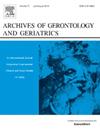晚年聋哑老年人的交流挑战和应对策略
IF 3.8
3区 医学
Q2 GERIATRICS & GERONTOLOGY
引用次数: 0
摘要
越来越多的成年人随着年龄增长而出现听力障碍。迟发性失聪患者在获得口语后经历了严重到深度的听力损失,他们在日常活动中往往面临着独特的沟通挑战。尽管存在这些困难,但人们对具体活动及其发生的环境知之甚少。目的确定迟发失聪老年人面临的沟通挑战,并探讨他们采取的应对策略来应对这些挑战。方法“老龄化问题、挑战和日常解决策略”(ACCESS)研究采用混合方法探讨长期残疾老年人面临的日常挑战。60名参与者(66.7%为女性;(年龄= 69.3,SD = 6.0),重度至重度双侧听力损失至少10年,完成问卷调查和结构化访谈。定性资料采用内容分析法进行分析。结果内容分析揭示了与医疗保健预约、娱乐活动、与不熟悉的人互动和团体活动的沟通挑战。具体困难包括一般听力障碍、具有挑战性的听力环境、辅助技术的局限性、对听觉刺激的依赖以及缺乏社会支持。为了应对这些挑战,参与者采用了各种策略,包括使用辅助技术、个人放大设备、沟通修复技术、自适应沟通方法和披露他们的听力状况。研究结果强调了晚期失聪老年人面临的各种沟通挑战。确定的战略说明了它们的弹性和适应性,但也强调了需要改进的领域。加强辅助技术、改善环境条件和支持性政策对于有效应对这些挑战至关重要。本文章由计算机程序翻译,如有差异,请以英文原文为准。
Communication challenges and response strategies of late-deafened older adults
Background
A growing number of adults are aging with hearing impairments. Late-deafened individuals, who experience severe to profound hearing loss after acquiring spoken language, often face unique communication challenges in everyday activities. Despite these difficulties, little is known about the specific activities and contexts where they occur.
Objectives
To identify activities that present communication challenges for late-deafened older adults and to explore the response strategies they adopt to manage these challenges.
Methods
The Aging Concerns, Challenges, and Everyday Solution Strategies (ACCESS) study uses a mixed-methods approach to explore the daily challenges faced by individuals aging with long-term disabilities. Sixty participants (66.7 % female; M age = 69.3, SD = 6.0) with severe to profound bilateral hearing loss for at least ten years completed questionnaires and structured interviews. Qualitative data were analyzed using content analysis.
Results
The content analysis revealed communication challenges with healthcare appointments, entertainment events, interactions with unfamiliar people, and group activities. Specific difficulties included general hearing impairments, challenging listening environments, limitations of assistive technologies, reliance on auditory stimuli, and insufficient social support. To manage these challenges, participants employed various strategies, including the use of assistive technologies, personal amplification devices, communication repair techniques, adaptive communication methods, and disclosing their hearing status.
Conclusions
The findings highlight the diverse range of communication challenges faced by late-deafened older adults. The identified strategies illustrated their resilience and adaptability but also underscored areas for improvement. Enhanced assistive technologies, better environmental accommodations, and supportive policies are essential to address these challenges effectively.
求助全文
通过发布文献求助,成功后即可免费获取论文全文。
去求助
来源期刊
CiteScore
7.30
自引率
5.00%
发文量
198
审稿时长
16 days
期刊介绍:
Archives of Gerontology and Geriatrics provides a medium for the publication of papers from the fields of experimental gerontology and clinical and social geriatrics. The principal aim of the journal is to facilitate the exchange of information between specialists in these three fields of gerontological research. Experimental papers dealing with the basic mechanisms of aging at molecular, cellular, tissue or organ levels will be published.
Clinical papers will be accepted if they provide sufficiently new information or are of fundamental importance for the knowledge of human aging. Purely descriptive clinical papers will be accepted only if the results permit further interpretation. Papers dealing with anti-aging pharmacological preparations in humans are welcome. Papers on the social aspects of geriatrics will be accepted if they are of general interest regarding the epidemiology of aging and the efficiency and working methods of the social organizations for the health care of the elderly.

 求助内容:
求助内容: 应助结果提醒方式:
应助结果提醒方式:


